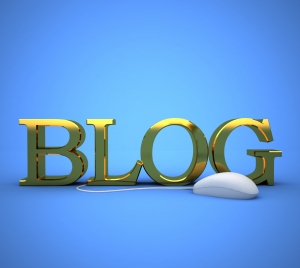 What makes a company blog stand out from the crowd?
What makes a company blog stand out from the crowd?
Whether it’s a corporate blog that reflects the company brand or its a blog that focuses on a single product or service brand, there are several elements that must be present in order for a company blog to be a successful.
Following are five key elements that go into developing a company blog that people will actually want to visit and read along with some examples that you can use for benchmarking.
5 Key Elements of Great Company Blogs
1. Relevant and Useful
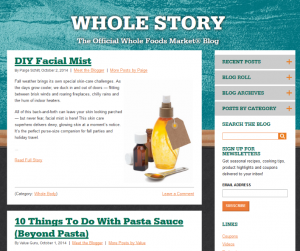 If the content of the company blog isn’t relevant to the target audience, that audience won’t visit and read it. Furthermore, if the content isn’t useful to them, they could click away with a negative perception of your brand in their minds. Bottom-line, irrelevant and useless blogs can actually damage your brand reputation, which can lead to negative word-of-mouth marketing and lost sales in the future. Instead, publish relevant and useful content that is highly shareable.
If the content of the company blog isn’t relevant to the target audience, that audience won’t visit and read it. Furthermore, if the content isn’t useful to them, they could click away with a negative perception of your brand in their minds. Bottom-line, irrelevant and useless blogs can actually damage your brand reputation, which can lead to negative word-of-mouth marketing and lost sales in the future. Instead, publish relevant and useful content that is highly shareable.
Example to Benchmark: Whole Foods
There aren’t many company blogs that get a lot of positive comments on their posts. Check out the Whole Story blog from Whole Foods and you’ll find tons of posts about recipes, food, and more. Read through the comments and you’ll see that they’re very engaging in a positive way.
2. Not Self-Promotional
 As with all social media marketing and content marketing, your blog content cannot be overly self-promotional. That doesn’t mean you can’t publish the occasional self-promotional blog post, but 80% of that post should be useful and no more than 20% should be self-promotional. In fact, the 80-20 rule should apply to all of your blog posts. Make sure that at least 80% of the posts you publish on your company blog are not self-promotional. If your blog reads like a series of ads or press releases, no one will stick around or visit again.
As with all social media marketing and content marketing, your blog content cannot be overly self-promotional. That doesn’t mean you can’t publish the occasional self-promotional blog post, but 80% of that post should be useful and no more than 20% should be self-promotional. In fact, the 80-20 rule should apply to all of your blog posts. Make sure that at least 80% of the posts you publish on your company blog are not self-promotional. If your blog reads like a series of ads or press releases, no one will stick around or visit again.
Example to Benchmark: Oracle
Visit the Modern Marketing Blog and you might not even realize its from Oracle. The Oracle Marketing Cloud logo in the upper right-hand corner of the page is the only clearly visible identifier when you first land on this blog. The posts are filled with information that is helpful to marketers with very little self-promotion.
3. Content Variety
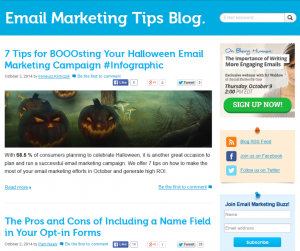 Avoid publishing the same type of blog post again and again. For example, if your brand is in the travel industry, avoid publishing post after post about the same travel destination. If your brand is in the email marketing industry, avoid publishing posts that are only about email marketing. Instead, go beyond the obvious content topics and look for indirectly related topics that can add variety and interest to your blog.
Avoid publishing the same type of blog post again and again. For example, if your brand is in the travel industry, avoid publishing post after post about the same travel destination. If your brand is in the email marketing industry, avoid publishing posts that are only about email marketing. Instead, go beyond the obvious content topics and look for indirectly related topics that can add variety and interest to your blog.
Example to Benchmark: GetResponse
GetResponse is an email marketing tool, but its blog isn’t entirely focused on email marketing. Visit this blog and you’ll get lots of useful information about email marketing, but also, you’ll find posts about social media, blogging, and much more. Nearly everything directly or indirectly relates to email marketing in some way, but the blog isn’t just a series of posts about that one topic. The variety of content makes it much more interesting to read on an ongoing basis.
4. Personality
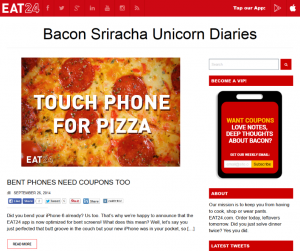 What is your brand personality? It should be reflected in your blog content. Your company blog should not read like a corporate document or an advertisement. It should read in a voice that will resonate with the audience and accurately reflects your brand personality. Of course, keep it professional!
What is your brand personality? It should be reflected in your blog content. Your company blog should not read like a corporate document or an advertisement. It should read in a voice that will resonate with the audience and accurately reflects your brand personality. Of course, keep it professional!
Example to Benchmark: Eat24
The Eat24 blog is a bit controversial, but that is exactly why it’s so great. Posts are snarky and often politically incorrect, but they fit the brand personality and the target audience. You don’t need to drop f-bombs in your company blog posts like Eat24 does, but do inject the personalities of the brand and the writers into every post to make them your brand seem human and more engaging.
5. User Experience
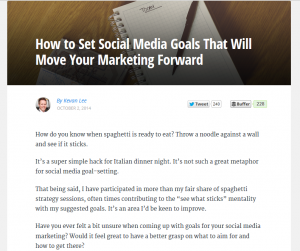 The user experience on your company blog must be reflective of your brand promise. For example, your company blog should be visually appealing and match your brand image. It should load quickly and be updated often to keep visitors coming back and to motivate them to tell their friends about it.
The user experience on your company blog must be reflective of your brand promise. For example, your company blog should be visually appealing and match your brand image. It should load quickly and be updated often to keep visitors coming back and to motivate them to tell their friends about it.
Example to Benchmark: Buffer
Buffer is a social media application that enables users to schedule social media updates to publish on multiple social media accounts using a single tool. The blog is filled with a variety of useful information that is not entirely self-promotional and accurately reflects the brand personality. The user experience is highly streamlined. There are no sidebars. There is no distracting clutter. Visitors only see the blog posts so they can focus entirely on the useful information contained within each post.
What are your favorite company blogs? Leave a comment and share your thoughts.
Image: Svilen Milev
Susan Gunelius is the author of 10 marketing, social media, branding, copywriting, and technology books, and she is President & CEO of KeySplash Creative, Inc., a marketing communications company. She also owns Women on Business, an award-wining blog for business women. She is a featured columnist for Entrepreneur.com and Forbes.com, and her marketing-related articles have appeared on websites such as MSNBC.com, BusinessWeek.com, TodayShow.com, and more.
She has over 20 years of experience in the marketing field having spent the first decade of her career directing marketing programs for some of the largest companies in the world, including divisions of AT&T and HSBC. Today, her clients include large and small companies around the world and household brands like Citigroup, Cox Communications, Intuit, and more. Susan is frequently interviewed about marketing and branding by television, radio, print, and online media organizations, and she speaks about these topics at events around the world. You can connect with her on Twitter, Facebook, LinkedIn, or Google+.

